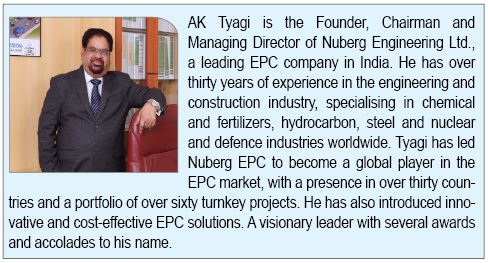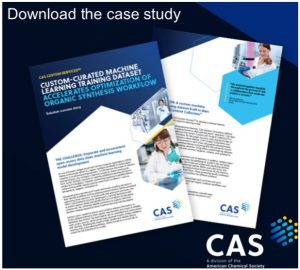
The start of the year is always a good time to invite a futuristic perspective on how the industry and economy will shape up. The world is at an inflexion point with several digitally driven technologies converging, that are expected to be not just transformative, but could create undreamt of paradigm shifts that could end result even in civilizational upliftments, unachievable before.
To understand the impact on industry, Chemical Industry Digest posed the questions below to CEOs. Two responses we received are published here. More responses on the way, will be taken up in subsequent issues.
AK Tyagi, Founder, CMD, Nuberg Engineering Ltd.
Chemical Industry Digest (CID): As the New Year has begun, it is always a time to look at the year that went by and then look forwards. So, what would you say are two or three of the most important trends of the last year that have impacted Indian business and industry, and more particularly, your industry?
AK Tyagi (AKT): The year 2023 was a challenging, but rewarding one for Indian business and industry, especially for the EPC sector. Among the many trends that shaped the market landscape, I would like to highlight three that had a significant impact on our industry.
The first trend is the digital transformation in the EPC industry. As the world faced unprecedented disruptions due to the pandemic, geopolitical tensions, and environmental crises, the EPC industry had to adapt quickly and embrace digital technologies to enhance efficiency, reduce costs, and improve project execution. Nuberg EPC aligned with this trend and invested in digital solutions, such as cloud-based collaboration platforms, remote monitoring and control systems, and digital twins, to enhance the project delivery and operation of various plants in the region. Nuberg EPC’s projects like PPU (Propylene Purification Unit) and SRU (Sulfur Recovery Unit) showcased the benefits of using digital tools such as 3D modelling, simulation, and virtual reality to design, engineer, and execute the plant.
The second trend is the supply chain disruption that the EPC industry faced despite the global recovery. The volatility of oil prices, environmental regulations, changing customer demands, and new entrants posed challenges for the EPC industry to maintain a stable and reliable supply chain. However, this also created growth opportunities for the industry to adopt advanced technologies, explore new models and alternatives, diversify the supply base and boost in-region sourcing. For critical materials it is important to move from global to regional networks, and leverage big data analytics to optimise the performance and efficiency of the supply chain.
The third trend is the ESG and sustainability trend that the EPC industry had to align with. As the pressure to comply with government initiatives, stakeholder expectations, and social responsibilities increased, the EPC industry had to focus on the sustainability impacts of their projects and operations. This involved using “green” construction materials, incorporating sustainable design, and setting up projects that contribute to the transition to a low-carbon economy. Looking forward, I believe that these trends will continue to shape the EPC industry and create new challenges and opportunities for us.
CID: How do you foresee both global and domestic economic situations evolving, their impact on industry and the industry trends you feel will shape the course of your industry in 2024?
AKT: The global and domestic economic situation is expected to improve in 2024 as the recovery from the pandemic and the geopolitical tensions continue. This will have a positive impact on the chemical industry, as the demand for chemical products will increase across various end-use sectors. The construction, automotive, and consumer goods industries, in particular, will benefit from higher chemical demand as they resume their normal operations and cater to the pent-up consumer demand.
However, the chemical industry will also face some challenges and opportunities in 2024 as it responds to the changing trends and regulations in the market. One of the key trends is the rising focus on environmental regulations and sustainability, as governments and consumers demand more eco-friendly and circular solutions. The chemical industry must adopt advanced technologies and processes to reduce its environmental impact and comply with regulatory standards.
Another key trend is the digital transformation of the chemical industry, as it leverages the power of artificial intelligence, big data, cloud computing, and other technologies to enhance its service delivery and performance. The chemical industry can use digital technologies to optimize its production, supply chain, R&D, and customer engagement, as well as to create new value-added services and solutions.
The chemical industry will also have to adapt to market expansion and regional developments in 2024 as it explores new opportunities and faces new competition in emerging economies and regions. Emerging economies, such as China, India, Brazil, Indonesia, and Thailand, offer a growing market for chemicals, as they have a large and growing population, rising income levels, and increasing industrialization and urbanization. The chemical industry will need to tap into this market potential by offering products and solutions that meet local needs and preferences, as well as by establishing local presence and partnerships.
Regional developments, such as the EU Green Deal and the carbon border adjustment mechanism, will also influence the chemical industry in 2024, as they will create new incentives and barriers for trade and investment. The EU Green Deal is a comprehensive plan to make the EU climate-neutral by 2050, and it includes various measures to reduce greenhouse gas emissions, promote renewable energy, and foster a circular economy. The carbon border adjustment mechanism is a proposed policy tool to impose a carbon tax on imports from countries with less stringent climate policies to prevent carbon leakage and ensure a level playing field. These developments will affect the chemical industry, as it will have to adjust its production, pricing, and sourcing strategies to remain competitive in the EU market. Economic recovery and growth, environmental regulations and sustainability, digital transformation, market expansion, and regional developments are the key trends that will shape the EPC industry in 2024.
CID: Digitalization is inescapable. What is the progress that you have made in your company in the digitalization of your operations? What benefits have accrued so far? How are you proceeding with reskilling your workforce for digitalization?
AKT: Digitalization is inescapable in today’s world, as it offers tremendous opportunities and challenges for businesses across industries. At Nuberg EPC, our digitalization initiatives are driven by two main objectives: to gain a competitive edge in the global EPC market and to enhance our services through digital technologies.
One of the key areas where we have digitalized our operations is project execution. We have adopted the EPC/LSTK (engineering, procurement, construction/lump sum turnkey) basis for executing Greenfield Projects, which enables us to deliver end-to-end solutions to our clients with better planning, scheduling, and control. This leads to improved efficiency and cost savings, as well as higher customer satisfaction and loyalty.
Another area in which we have digitalized our operations is software integration for project management. We utilize various software tools across project phases, including feasibility studies, design, engineering, procurement, construction, and commissioning. Some of our latest tools and software are PIRS, AUTOCAD, HTRI, PRIMAVERA, PV Elite, ISOMAC, ProSteel, and STAAD Pro. These tools help us streamline our processes, reduce errors, and improve the overall quality of our projects.
A third area where we have digitalized our operations is digital transformation for sustainability. We design our projects to minimize energy consumption, carbon emissions, water usage, and waste generation, and we leverage advanced technologies such as AI, big data analytics, cloud computing, IoT, robotics, and 3D printing to enhance our productivity, quality, safety, and transparency. These technologies also help us create innovative and customized solutions for our clients, such as the advanced Sulfuric Acid technology (DCDA) that reduces SO2 emissions by 99.9% and recovers heat and power from the process.
A fourth area where we have digitalised our operations is workforce reskilling. We recognize that digitalization requires a skilled and competent workforce that can adapt to the changing environment and meet the evolving needs of our clients. We have not provided specific details on our workforce reskilling programs, but our focus is likely on upskilling our employees in digital technologies and sustainable practices. We offer potential training in advanced technologies and sustainable project management practices among employees. We aim to keep our workforce relevant and competitive in a digitalized and sustainable environment.
CID: As you know Artificial Intelligence (AI) together with voluminous data management and analytics are bringing innovative paradigm-changing transformations for business and industry. What are your plans and strategies to incorporate AI in your business?
AKT: Artificial Intelligence (AI) is a game-changer for businesses and industries, as it enables the management and analysis of voluminous data and the creation of innovative solutions. At Nuberg EPC, we have a clear vision and strategy to incorporate AI into our business. Our AI integration plan covers five key areas: predictive maintenance, improved decision-making, risk management, automation for efficiency, and augmented intelligence.
Predictive maintenance is one of the areas where we plan to use AI to enhance our operations. AI can help us analyse the data from our machinery and equipment and predict potential failures and malfunctions before they occur. This way, we can prevent costly breakdowns, reduce downtime, and optimize our maintenance schedules and costs.
Improved decision-making is another area where we plan to use AI to improve our performance. AI can help us process large volumes of data from various sources, such as market trends, customer feedback, project reports, and financial statements, and provide valuable insights and recommendations for our decision-making. AI can also help us identify patterns and trends in our project data and enhance our understanding and prediction of project schedules, costs, and outcomes.
Risk management is a third area where we plan to use AI to support our planning and execution. AI can help us understand and predict the risks associated with our projects, such as technical, financial, environmental, and regulatory risks, and optimize our planning and mitigation strategies accordingly. It can also help us detect anomalies and deviations in our operations and take responsive actions to ensure safer and more efficient operations.
Automation for efficiency is a fourth area where we plan to use AI to increase our productivity and quality. AI can help us automate some of the repetitive and tedious tasks in our processes, such as data entry, documentation, invoicing, and reporting, and free up our human resources for more complex and creative endeavours. AI can also help us improve the quality and accuracy of our work by reducing human errors and inconsistencies.
Augmented intelligence is a fifth area where we plan to use AI to complement and enhance our human intelligence. AI can help us process vast amounts of data and generate significant possibilities for our long-term planning and immediate decision-making, but it cannot replace our human expertise and judgment. AI can provide us with support and assistance, but we will still have the final say and responsibility for our actions and outcomes.
However, we also recognize that implementing AI in our business is not without challenges and considerations. One of the main considerations is the investment requirement for AI technologies. We will need to invest in acquiring, developing, and maintaining the AI technologies that suit our needs and goals. We will also need to invest in developing our data infrastructure, such as data collection, storage, security, and governance, to enable effective AI utilization.
Another consideration is workforce reskilling for AI integration. We have reskilled some of our employees to manage and interpret the AI outputs and to adapt to the AI-driven processes. We also ensure that our employees are comfortable and confident with using AI and that they understand the benefits and limitations of AI. We provide them with adequate training and support to facilitate their transition and integration.
AI is a powerful and transformative force for business and industry, and we have a clear and comprehensive plan and strategy to incorporate AI into our business. We plan to use AI in five key areas: predictive maintenance, improved decision-making, risk management, automation for efficiency, and augmented intelligence. We also consider the investment requirements and workforce reskilling for AI implementation. We envision AI as a revolutionary force driving efficiency and innovation.
CID: It is a high-tech world we are in, as never before. Those who hold the levers of technology will dart forward, driving business fortunes. This means for those companies investing in result-oriented R&D. To what extent is this perception held dear and to what extent is your R&D and innovation driving your business?
AKT: We live in a high-tech world, as never before, where technology is the key driver of business success and growth. We firmly believe that investing in result-oriented R&D is essential for staying ahead of the curve and creating value for our clients and stakeholders. Our R&D and innovation efforts are driving our business in various ways, such as:
- Developing advanced chemical production technologies, such as the Double Contact Double Absorption (DCDA) technology for high-grade sulfuric acid production. This technology reduces SO2 emissions by 99.9% and recovers heat and power from the process, ensuring sustainability and cost-effectiveness. We have successfully implemented this technology in several projects across the globe, such as in Egypt, Ethiopia, and Saudi Arabia. Furthermore, we operate a research and development facility in Sweden, where we have developed proprietary in-house process patent technology for Hydrogen Peroxide across various product lines.
- Enhancing our operational efficiency by utilizing advanced software tools for streamlined project management. We have a team of 300+ engineering professionals across various disciplines, such as FEED, Basic, Detail, Piping, Instrumentation, etc. We use various software tools, such as PIRS, AUTOCAD, HTRI, PRIMAVERA, PV Elite, ISOMAC, ProSteel, and STAAD Pro, to optimize our processes, reduce errors, and improve the overall quality of our projects.
- Developing and owning one of the best technologies for Hydrogen Peroxide, duly patented. This technology enables the production of high-purity hydrogen peroxide, which has various applications in industries such as pulp and paper, textiles, mining, and environmental engineering. We have also established an R&D JV with EB Nuberg, Sweden, to further enhance our technological capabilities and offerings.
- Adopting digital technologies for service delivery, such as the Engineering, Procurement, and Construction (EPC)/Lifecycle Support, Turnkey (LSTK) basis for executing Greenfield projects. This enables us to deliver end-to-end solutions to our clients with better planning, scheduling, and control. This leads to improved efficiency and cost savings, as well as higher customer satisfaction and loyalty.
- Our R&D and innovation activities have a positive impact on our business, as they enable us to Innovate and remain competitive in the global EPC market. Our ability to develop new and advanced technologies attracts clients from various sectors and regions and generates increased revenue and market share for us. We have executed over 60 projects in more than 32 countries and have a strong presence in the Middle East, Africa, Europe, and Asia.
- Contribute to sustainability and social responsibility. Our focus on sustainable practices and technologies contributes to a more efficient and sustainable society, as we help our clients reduce their environmental impact and comply with regulatory standards. We also align our business goals with broader societal objectives, such as the UN Sustainable Development Goals.
We hold the perception that investing in result-oriented R&D is vital for our business success and growth, and we have a clear and comprehensive strategy to do so. Our R&D and innovation efforts are driving our business in various ways, such as developing advanced chemical production technologies, enhancing our operational efficiency, developing and owning one of the best technologies for Hydrogen Peroxide, and adopting digital technologies for service delivery. Our R&D and innovation activities also have a positive impact on our business, as they enable us to innovate, remain competitive, and contribute to sustainability and social responsibility.
CID: In a matter of the last few years to now and into the future many technologies are converging. Apart from Industry 4.0 and AI, other transformational technologies are Machine Learning, 3D Printing, Blockchain, Robotics, Drones, Synthetic biology, Virtual Reality and Augmented Virtual Reality, Digital Twins and perhaps more to come.
What are your views on this huge convergence of transformational technologies and what could be the shape of things to come?
AKT: We are witnessing a huge convergence of transformational technologies in the present and future world, which is reshaping the way we do business and industry. Apart from Industry 4.0 and AI, which are already disrupting the market, we also see the emergence and integration of other technologies, such as Machine Learning, 3D Printing, Blockchain, Robotics, Drones, Synthetic Biology, Virtual Reality and Augmented Virtual Reality, Digital Twins, and more. These technologies offer new possibilities and challenges for creating value and solving problems.
We are aligning our business strategy with the future of Industry 6.0, which is the next paradigm shift in manufacturing and services. Industry 6.0 is characterized by virtualized, customer-centric, and collaborative production, where humans and machines work together seamlessly and intelligently. Industry 6.0 also emphasizes sustainability and social responsibility, as it aims to optimize the use of resources and minimize the environmental impact.
We are applying these technologies in various aspects of our business, such as:
- Predictive maintenance is where we use Machine Learning and AI to analyse the data from our machinery and equipment and predict potential failures and malfunctions before they occur. This way, we can prevent costly breakdowns, reduce downtime, and also optimize our maintenance schedules and costs.
- Custom parts production is where we use 3D Printing and Robotics to produce customized and complex parts and components for our projects according to the specific needs and preferences of our clients. This way, we can reduce the lead time and inventory costs and also improve the quality and accuracy of our products.
- Secure transactions, where we can use Blockchain and Drones to facilitate secure and transparent transactions and deliveries for our projects across various regions and countries. This way, we can enhance the trust and reliability of our services and also reduce transaction costs and risks.
- Automated assembly lines, where we can use Robotics and AI to automate some of the repetitive and tedious tasks in our processes, such as data entry, documentation, invoicing, and reporting, and free up our human resources for more complex and creative endeavours, This way, we can increase our productivity and efficiency and also reduce human errors and inconsistencies
- We also have a future outlook for these technologies, where we envision humans controlling machines using brain power through technologies such as Brain-Computer Interfaces (BCIs) and Neuralink. This way, we can achieve a higher level of integration and interaction between humans and machines and also unlock new potential and capabilities for our business. We are also aiming for user-oriented, resource-efficient, and sustainable manufacturing solutions, where we use technologies such as Synthetic Biology, Virtual Reality and Augmented Virtual Reality, and Digital Twins, to create innovative and eco-friendly solutions for our clients and society.































